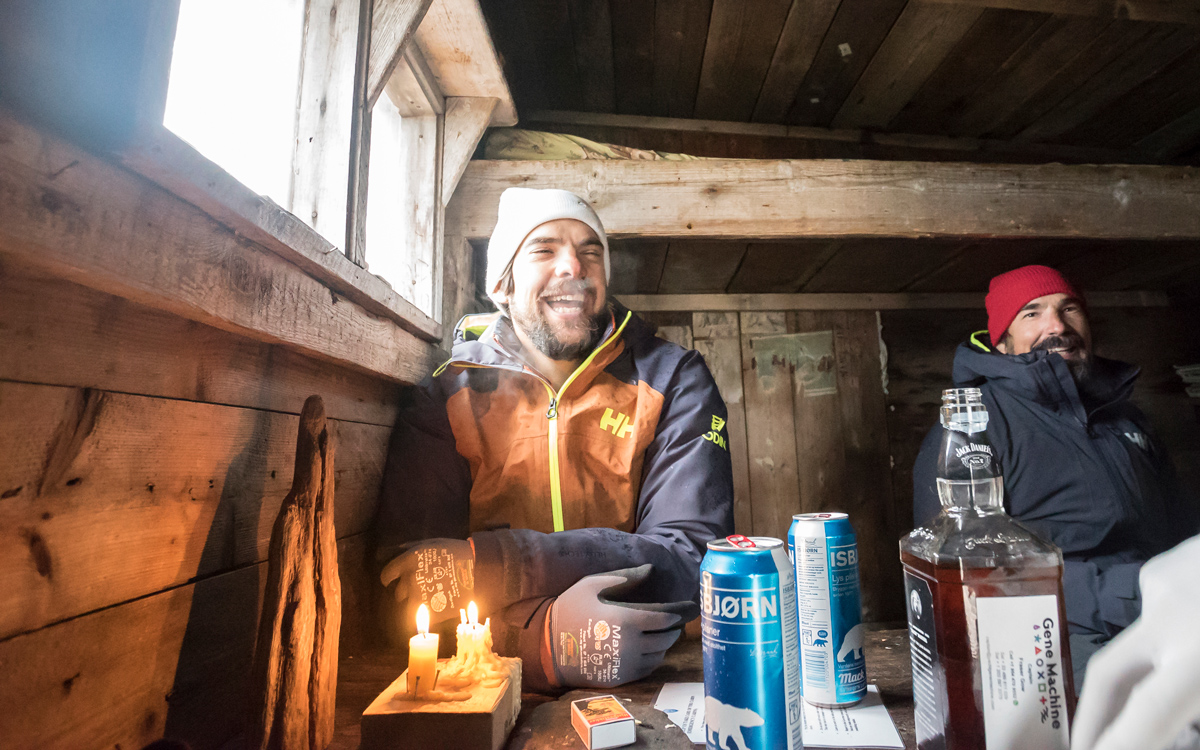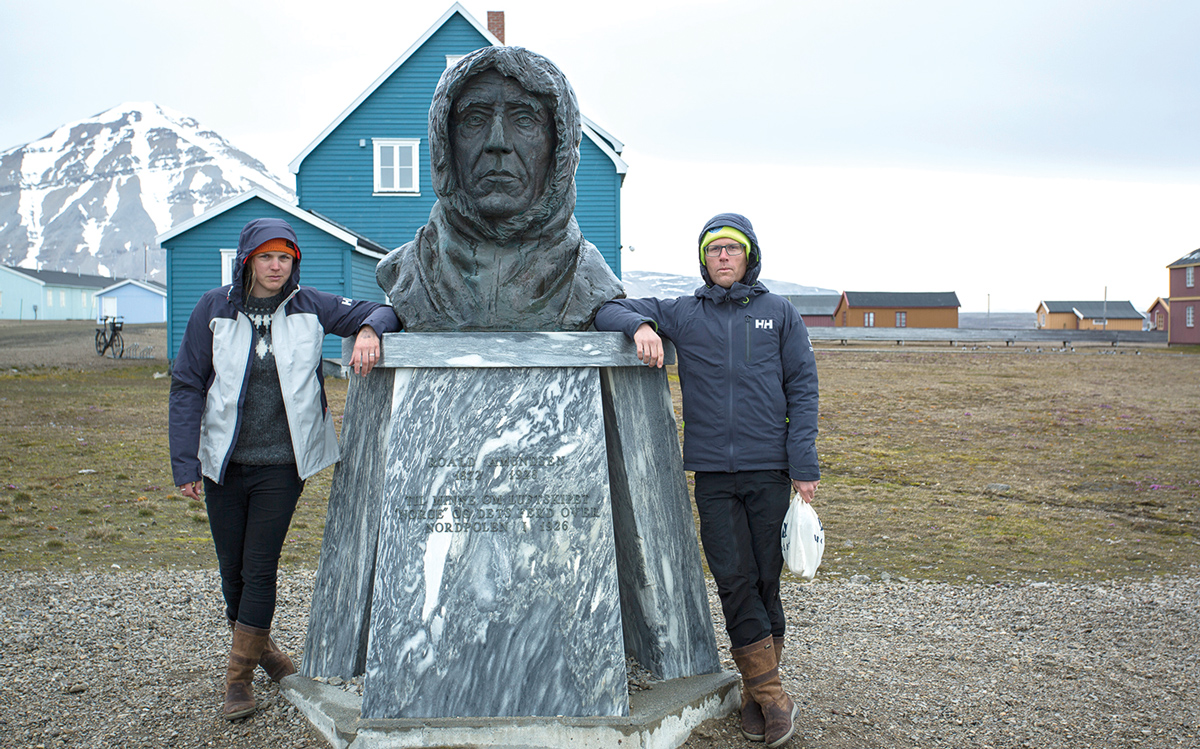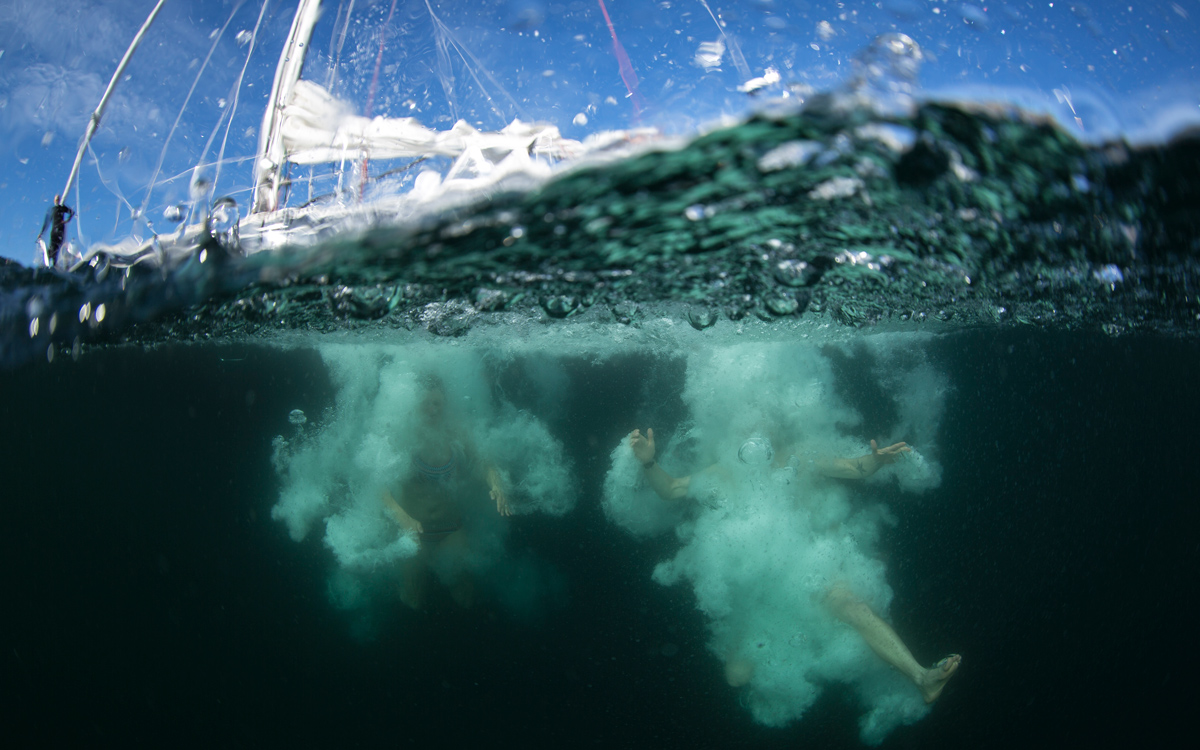Heading to the high Arctic got Andy Schell so stressed he thought he was having heart trouble. Yet the voyage to Svalbard proved to be more than worth the stress
“Congratulations, captain.” Dave McKay, one of our regular crew aboard Isbjörn, had those words for me as we dropped anchor at 77°N in Spitsbergen. We’d made it to the high Arctic. “Thanks Dave, but save it – you can congratulate me when we’re back out of the Arctic.”
Nobody talks about stress. For two months in the far north, every magical experience we had aboard Isbjörn, our 1972 Sparkman & Stevens Swan 48, was dampened ever so slightly in a cloud of anxiety as we pushed the boundaries of our comfort zones and explored the unexplored regions of our confidence.
After nearly letting stress derail our Arctic season before it even started, in the end it was our ability first to acknowledge and finally to manage that stress that enabled us to stay in the moment and make our summer in the Arctic unforgettable.
The boat had spent the winter in the refit shed at Vindö Marin on the west coast of Sweden getting new systems installed for the Arctic. My wife, Mia, and I spent the winter at our farmhouse on the other side of Sweden managing the logistics. By 1 May, when our first crew joined the boat in Marstrand for the North Sea crossing to Orkney to start the season, I was mentally fried.
A relentless westerly blew for days. We killed time with weather briefings and a survival suit demo in the 8°C water. As the westerly blew and blew, I grew more and more anxious. We were about to depart on the most challenging season of our sailing career and we couldn’t even leave the dock. Tick-tock, tick-tock, tick-tock.
All of this was taking its toll on me and, crucially, I wasn’t allowing myself to admit it. I’m a pro, I’m a leader, I don’t get stressed, I can’t get stressed. Come on.
Finally, a respite. The wind backed into the south-west just long enough for us to cross the Kattegat to Skagen, Denmark. I laid in my bunk for most of that 40-mile sail. I was so stressed I feared I was having a heart problem. Next morning we went to a local clinic in the pretty seaside town and met a sympathetic doctor who told me: “Yes, this is stress,” and: “Given what you’re about to attempt, what do you expect?” She offered to give me an ECG right there on the spot to ease my mind about the heart thing. Yes, please.
It was clear, of course. I’m only 34, after all, and otherwise fit and in perfect health. The doctor printed out the result. I returned to Isbjörn, gathered the crew around the saloon table, and without a word placed the ECG result on the table. “This is where I’ve been,” I admitted.
We spent the rest of the morning in an honest debrief, discussing how to handle stress, why more people don’t discuss it openly and why it had taken me so long to do just that. I offered all the crew the chance to leave the boat right then and there, no questions asked, full refunds provided if they’d lost confidence in me as a leader.
On the contrary, they were thankful that someone (finally!) had voiced the same concerns they had on their own boats back home, and we ended up with a memorable teachable moment. Next day the wind eased off and we finally got out to sea. We were on our way to the Arctic.
Fast forward to northern Norway. After my meltdown in Skagen, things changed dramatically. Simply by allowing myself to acknowledge my own vulnerabilities as a skipper and, armed with the knowledge that I was in fact physically healthy, my mental state changed almost overnight.
Across the Barents Sea
We had a spectacular passage from Lerwick nonstop to Bodø, crossing the Arctic Circle on 26 May and celebrating with the first of many Arctic swims. After cruising through the Lofoten Islands and changing crew in Tromsø, it was time for the first real high latitude test: crossing the Barents Sea to Spitsbergen.
I had one last phone call to Maik Brötzmann, a friend at Haf-Strand we’d hired to do our ice forecasting for Svalbard. “You’ve got the experience Andy,” Maik told me. “I know this means a lot to you. You might have a few surprises, but get out there and sail. I know you can do it.”
With Maik’s vote of confidence and a good omen in the handful of eagle feathers Mia found on the beach, we weighed anchor at 0100 and had a beautiful sail out of the fjords. The midnight sun lit up the snow-covered mountains on either side of us, and there was enough wind funnelling through the valleys that we sailed, racing the developing low off Greenland to the north-west. In the end, we beat it, and had good if not perfect weather, relatively speaking – it snowed a lot, was overcast for much of the time, but we had no storms and favourable wind angles.
Closing Spitsbergen, the visibility disappeared. The mountains at Sørkapp, supposedly visible from 75 miles off on a clear day, remained elusive in the snow showers and overcast skies. Water flew around on deck, but the cockpit remained mostly dry, though with the increasing snow showers and pervasive damp, it was cold on watch.
What is life cruising on a superyacht really like? To the Antarctic on Adele
David Glenn finds out what it's really like cruising on a superyacht
Faeroes to Norway in a Wayfarer dinghy – Frank Dye’s extraordinary tale of sea survival
When I was a student in Liverpool in the mid-1960s, sailing the university’s Firefly dinghies when I ought to have…
Finally…“Land Ho!” At 12 miles off the coast, Mia spotted Spitsbergen. To starboard in the grey murk, the black and white, jagged mountains around Sørkapp resolved into view.
When the fierce easterly wouldn’t let us in the mouth of Hornsund, Spitsbergen’s southernmost fjord, Mia located a nice spot on the chart just a few miles north among some small off-lying islands at the terminus of two massive glaciers. At 0115 on 11 June 2018, and three days, 17 minutes after we weighed anchor at the top of Norway, Isbjörn made fast to the bottom in Spitsbergen.
After securing the anchor rode, I called for the engine to be shut down and, with that, raised my arms in triumph. The crew high-fived. Mia & I hugged. As I like to think the polar explorers back in the day would have done, we shared a dram of whisky.
Dancing with the ice
Nerves can be a good thing. I used to be a competitive golfer, and feeling nervous on the first tee of a big tournament was part of the excitement. Nerves keep you focused. A little stress keeps you on your guard. New to Svalbard, our nerves heightened our senses. We were open to being awed.
The mountains in Hornsund resemble the Himalayas, with their jagged peaks and rocky spires, except that they plunge right into the sea. Sailing further into the fjord, an impossible knife-edge ridge off the port stern quarter was frozen along its top and blanketed with fresh snow, apart from the jet-black flanks of the eastern-facing cliffs, which fell straight into the sea from 700m.
The mountains extended up the fjord for five miles, framing a glacier in the eastern valley. Further east still and a bit south, a pyramid-shaped peak marked a point dividing Burgerbukta into two north-south fjords arranged in a steep V-shape, like someone giving the peace sign.
These were lousy with icebergs. Drifting out of the adjacent fjords on the same northerly breeze Isbjörn sailed came brilliant blue chunks of ice, some the size of basketballs, some larger than my house.
We hardened the sheets and went in to dance. I was on high alert, but this time my nerves were working for me. It felt as if all those summers I had spent sailing the schooner Woodwind in close quarters around the moored boats in Annapolis, or on our yawl Arcturus in the Stockholm archipelago in the narrow channels between rocks and skerries, had prepared me for this very moment. I was in my element.
For the next few hours, we sailed deeper into the ice. Mia stood watch at the bow, using hand signals to guide Isbjörn past the smallest bits of ice I couldn’t see from the helm, while I often deliberately aimed for the larger bergs for a closer look. We’d pinch up to slow Isbjörn’s way just enough to dodge the heaviest ice, then foot off on a close reach when the leads got wider, sailing at over 7 knots at times and yet in full control.
It was simultaneously the most challenging yet effortless sailing I’ve ever done. The focus required in that moment eliminated any anxieties I might have had thinking about it.
We cleared the last of the ice and gybed in front of the big blue face of Korberbreen glacier to head around Treskelodden and deeper into Hornsund. We had a big chunk of glacial ice we’d earlier collected in the dinghy sitting on Isbjörn’s transom, and I had an idea.
James fetched his ice axe while I dug out the bottle of Ironworks Rum leftover from the little Lunenburg distillery we always visit when in Nova Scotia, and on a broad reach surrounded by nature, we toasted the day with rum and 10,000-year-old ice.
What more can you say?
It would take a book to describe the entirety of our time in Svalbard. The days melted together in the midnight sun, and our timetables got wholly out of whack.
If the sun was out, we went on adventures. We went hiking to glaciers, or swimming amongst the brash ice. We hung out with walrus. If it was lousy weather, we slept.
The time of day well and truly did not matter. This went on for three blurry weeks while we sailed up the west coast and around to mythical ‘Texas Bar’ in the north.

SV Delos crew on a late-night whisky mission to the Texas Bar hut in Woodfjorden, northern Spitsbergen
In a nutshell, Svalbard was easily the most starkly beautiful place I’d ever sailed. The fjords in northern Norway are spectacular. Svalbard is something else entirely. Strictly speaking, the Arctic is defined by the Arctic Circle, at 66° 33’ north latitude, which in turn is defined by the limits of the midnight sun, and is determined by the Earth’s tilt (which is 23½°).
But that doesn’t quite do it justice: northern Norway is technically Arctic, but when you contrast it with the scenery, wildlife and remoteness of Svalbard, it’s an entirely different ecosystem.
We got lucky in Svalbard – on one single afternoon up in what’s known as the ‘north-west corner,’ we saw walrus chilling on the beach, a mother polar bear and her cub ambling along the shoreline in search of food, and a pod of hundreds of beluga whales. In one day!
We sailed as far as 80°N, an arbitrary but awesome goal, within 600 miles of the North Pole. Aside from a frozen-over Fridtjofhamn in Bellsund, we didn’t see a single flake of pack ice, a grim reminder of our changing climate and its consequences. Svalbard is a land of extremes, and it delivered.
Sailing safely south
If the theme of our Arctic summer was managing stress, I knew I wouldn’t fully relieve myself of it until we’d gotten safely out of the Arctic. And to do that, we had our most ambitious passage yet ahead of us: 1,000 miles to Iceland, with nowhere to hide on the way. East Greenland was frozen in the ice and in any case truly wilderness. To Iceland!
Ironically, the passage south was a test of patience as we battled calms, not storms. When the wind died, we motored at a slow 1,500rpm to save on fuel, and anytime the slightest breeze blew up, we sailed. We had a magnificent spinnaker run, setting the chute when the first sign of a north-easterly set in. James launched the drone in the evening and got some of my favourite shots ever of Isbjörn cranking along under the big white sail, from directly above. Christmas card material.
We started to hear Icelandic spoken on the VHF as we neared the northern coast and, after not visually seeing a single ship on the route south (and only one sailboat on AIS, headed north), suddenly the chart was covered in AIS targets from fishing boats surrounding the Westfjords. It always feels weird re-entering civilisation after a long ocean passage, but considering where we’d come from, Iceland might have been the strangest re-entry yet.
We motored into Isafjordur and were greeted on the pier by our friend Siggi, skipper of Aurora Arktika, with whom we had sailed earlier in March on a sail-and-ski trip in these same Westfjords. Later that evening, after showers and a hot meal, the typical post-passage stuff, Siggi and his crew preparing their two boats to go to Greenland came over for beers in the cockpit of Isbjörn. Maik, our ice pilot (who also lives in town), came down with his girlfriend. Oly, the mate on Arktika during our ski trip came over too.
After the long summer in the far north, the Westfjords were comfortably familiar. It felt like a homecoming. And, by the way, Isafjordur is ten miles below the Arctic Circle – we’d made it out.
A turning point
I’ve vacillated about whether we’ll ever go back to the high Arctic. If you’d have asked me back in Skagen at the doctor’s office, I’d have said no way, and would have wondered why I was so enthusiastic about planning it in the first place.
And yet Skagen marked a turning point. When we danced with the ice that day in Hornsund I remember mentioning to James that, gosh, all that stress and anxiety leading up to this point was totally worth it. I said then and there that we’d definitely be back.
Now what do I think, having safely returned? I’m not sure. I need more time to reflect on the enormity of what we just did. We’ve got a lot of sailing ahead of us yet this season, and I still believe what I said to Mia long ago, that I won’t truly relax until Isbjörn is moored in Portugal and I can go back to the farm in Sweden for a few months this fall to decompress.
I believe now that anticipating and managing stress is the single most important aspect of successful adventure sailing, and is an overlooked part of the preparation. It certainly was in our case, anyway.
The five weeks in Svalbard were life-changing, in a very positive way. Experiences that on the surface should have been stressful were quite the opposite. That iceberg dancing in Hornsund was one of them. I was magnetically pulled into that sound and towards the ice, and in the moment felt nothing but pure joy. Genuinely.
Like when you’re standing over a big putt on the 18th green, you’re truly present in those kinds of moments, and there is no room for stress.
















